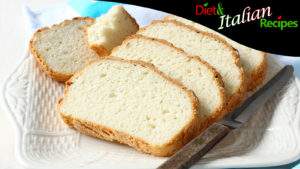Gluten-Free Bread Recipe with Rice Flour and Potato Starch
Gluten-free bread recipe with rice flour and potato starch to make a crispy outer crust, soft inside, and suitable for celiacs.
Doses for 500 g
Calorie per porzione360kcal
Cost Low
Other details
- Difficulty: medium
Ingredients
Ingredients for gluten free Bread
- 340 g Rice flour (2.83 cups)
- 200 g Potato starch (1.59 cups)
- 5 g Guar gum (2 teaspoons)
- 350 g Water (1.48 cups)
- 10 g Fresh yeast (1 tablespoon)
- 5 g Salt (1 teaspoon)
- 5 g Extra virgin olive oil (1 teaspoon)
Instructions
How to make Gluten-Free Bread with Rice Flour
- To make gluten-free bread with rice flour, pour most of flour onto a work surface, keeping the rest aside. Also, add potato starch and guar gum.
- Dissolve fresh yeast in a glass of water. Create a well in the center of the flour mound with your fingers, and pour some water with yeast into the center. Gradually pour water and yeast into the mixture, ensuring it is well absorbed. Start kneading with a fork, gathering the flour from the edges. When the dough in the center resembles a thick batter, pour more water and yeast until all the water and yeast are incorporated.
- Continue kneading the dough by hand on the work surface until it starts to take shape. At this point, add salt and olive oil. Keep working the dough by hand until it becomes smooth and uniform on the surface.
- Next, choose a medium-sized bowl and grease it with a drizzle of oil. Place the dough in the bowl and let it rest in a warm place, such as an oven with the light on (if it's winter or very cold). It will take about 60-90 minutes for the rice flour dough to double in size.
- When the dough has doubled, sprinkle some flour on a work surface and overturn the bowl, releasing the dough onto the surface.
- Using the flour on the work surface, give the final shape to our gluten-free bread. It's a delicate dough that can break easily, so gently roll it on the work surface to form a loaf shape. Remember to slightly fold the side edges inward to ensure even baking.
- For baking the gluten-free bread, line a 22 cm (8.7 inches) loaf pan with parchment paper. Transfer the dough to the pan and let it rise for another 60-90 minutes (depending on the ambient temperature, which can be colder or warmer).
- After the second proofing time, brush the surface with extra virgin olive oil to prevent it from drying out, and bake at 200°C (392°F) for 45-50 minutes. Once baked, remove it from the oven. Let it sit at room temperature for a few minutes to cool down.
- Unmold the bread and place it vertically, resting it on the kitchen counter with a clean kitchen towel underneath to prevent it from slipping. Keeping the bread in this position will help dry the interior of the gluten-free bread, preventing it from being moist as homemade bread usually is. It should remain in this position until it has completely cooled down.
- Once completely cooled, you can slice your gluten-free rice flour bread, and it will stay fresh for a longer time (do not cut it while it's still warm, as it won't be as good).
Tips
Do not slice the bread before it has completely cooled down: let it have enough time for all the moisture from baking to evaporate, resulting in a softer and better-tasting bread.
When the bread becomes stale (from the third day onwards), you can slice it and quickly make bruschetta in a pan to enjoy a crispy gluten-free.
